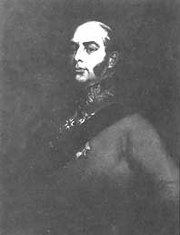Prince Edward Augustus, Duke of Kent and Strathearn
|
|
Template:House of Hanover His Royal Highness The Prince Edward Augustus, Duke of Kent and Strathearn (2 November 1767 - 23 January 1820) was the fourth son of King George III and the father of Queen Victoria. He was created Duke of Kent and Strathearn and Earl of Dublin on 23 April 1799.
Prince Edward Augustus was born in Buckingham Palace. In 1785, he began his military training in Germany. King George III intended to send him to the University of Göttingen, but decided against it upon the advice of the Duke of York. Instead, Prince Edward went to Lüneburg and later Hanover, accompanied by his tutor, Baron Wangenheim. He spent an additional two years in Geneva, before being sent to Gibraltar. There, he served as colonel of the 7th (Royal) Fusiliers. However, his severe sense of discipline made him unpopular among his troops. The Fusiliers were ordered to Canada in May 1791. The prince was promoted to the rank of major general in October 1793 and lieutenant general in January 1796. In May 1799, the newly created Duke of Kent was promoted to the rank of general and appointed the commander-in-chief of the forces in British North America. On 24 May 1802, the Duke began an appointment as governor of Gibraltar, with express orders by the government to restore discipline among the troops. However, the Duke's harsh discipline precipitated a mutiny by soldiers in the Royal Fusiliers and the 25th Regiment on Christmas Eve 1802. The Duke of York, then the commander-in-chief of the British Army, recalled him in May 1803 after receiving reports of the mutiny. The Duke of Kent formally held the governorship of Gibraltar until his death, although the Duke of York forbade him to return. As a consolation for the end of his active military career, he was promoted to the rank of field marshal and appointed Ranger of Hampton Court Park on 5 September 1805. The Duke of Kent continued to serve as honorary colonel of the 1st Regiment of Foot (the Royal Scots) until his death.
Prince Edward Augustus became a Knight of the Order of St. Patrick on 5 February 1783 and a Knight of the Order of the Garter on 2 May 1786. George III made him a member of the Privy Council on 5 September 1799. His elder brother, the Prince Regent (later King George IV), created the Duke of Kent a Knight Grand Cross of the Order of the Bath in the military division on 2 January 1815 and a Knight Grand Cross of the Royal Guelphic Order (military division) on 12 August 1815.
The Duke of Kent had a number of mistresses, most notably Adelaide Dubus (with whom he may have had an illegitimate daugther) and later Julie de St Laurent. However, he remained single until 1818 when, following the death of the heir presumptive to the throne, Princess Charlotte Augusta, the succession began to look uncertain. The Prince Regent and his younger brother, the Duke of York, had no surviving legitimate children. The other unmarried sons of King George III, the Duke of Clarence (later King William IV), the Duke of Kent, and the Duke of Cambridge, all rushed to contract lawful marriages and provide an heir to the throne. (The sixth son of King George III, the Duke of Sussex, had already married, albeit in contravention of the Royal Marriages Act of 1772.)
The Duke of Kent became engaged to Princess Viktoria of Saxe-Coburg-Saalfeld (17 August 1786 - 16 March 1861), the daughter of Francis I, Duke of Saxe-Coburg-Saalfeld and the widow of Emich Karl, Prince of Leiningen. She was also the sister of Prince Leopold of Saxe-Coburg-Saalfeld, the widower of Princess Charlotte Augusta. The couple married on 29 May 1818 at Schloss Ehrenburg, Coburg and again on 13 July 1818 at Kew Palace, Richmond Park, Surrey. Their only child, Princess Alexandrina Victoria of Kent, was born in May of the following year. However, the Duke of Kent died on 23 January 1820 at Woodbrook Cottage, Sidmouth, Devon, after a brief illness. He was buried at St. George's Chapel, Windsor Castle, but his remains were later moved the Kent Mausoleum, Frogmore, Windsor. He predeceased his father, George III, by six days.
The Duke of Kent predeceased his three elder brothers, but, since none of them had any surviving legitimate children, his daughter was next in line for the throne on the death of King William IV in 1837.
The Canadian province of Prince Edward Island is named in honour of Prince Edward.de:Eduard, Herzog von Kent

